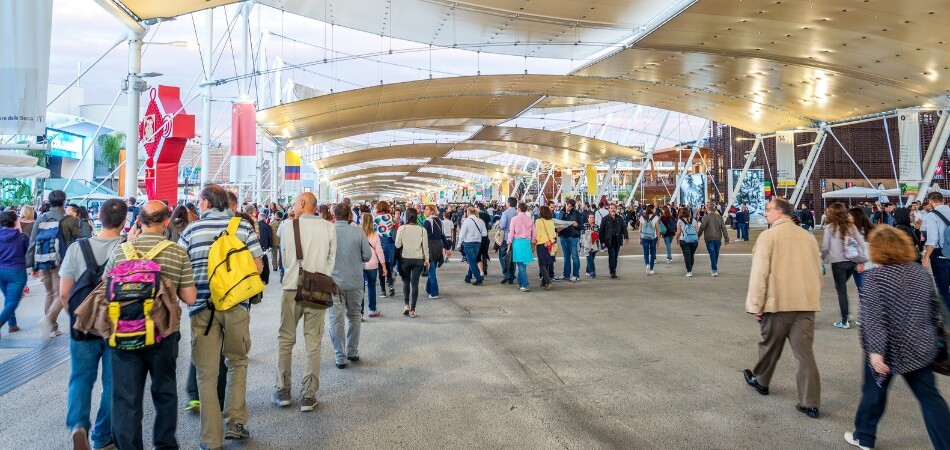Navigating the world of business events can sometimes be confusing, especially when terms are used interchangeably. Picture yourself planning to attend an event, only to realize upon arrival that it’s not open to the public! One common question that arises in this domain is, what is the difference between trade shows and fairs?
At a glance, both may seem quite similar, as they’re both avenues for businesses to showcase their offerings. However, the distinction lies in access. While trade shows are often accessible to the general public, a trade fair is exclusively for professionals in the industry.
This ensures that companies can buy and sell goods or services directly from each other, away from the public’s eye. Dive in with us as we explore this distinction further.
Definitions of Trade Shows and Fairs- A Brief Overview
In the bustling world of business events, understanding terminologies is paramount. Trade shows and fairs stand as prominent examples. Their distinctions are subtle yet significant.

Trade shows primarily serve as platforms where businesses unveil new products or services to the market. Open to the general public, these events encourage interaction between businesses and potential customers. Here, innovation meets curiosity, leading to fruitful exchanges and network building.
On the other hand, trade fairs exude a more exclusive aura. Designed solely for professionals in the industry, they restrict public access. This setup fosters a focused environment where businesses can directly buy and sell to one another.
Understanding these nuances ensures one’s preparedness and helps optimize the experience at such events. Whether public engagement or professional dealings, choosing the right event matters.
Types of Trade Shows
Trade shows come in various flavors, each catering to specific goals and audiences. Their diversity ensures every niche finds its spotlight. Here’s a quick dive into their types.
Consumer Trade Shows
These are geared towards the general public, showcasing products directly to consumers. They’re ideal for companies looking to engage customers directly. Think tech expos or car exhibitions.
B2B Trade Shows
Exclusively for businesses, these events facilitate industry networking. Attendees explore potential partnerships, distributors, or suppliers. Innovation meets commerce in these settings.
Hybrid Trade Shows
Marrying elements from both, these shows cater to both consumers and businesses. Morning sessions might be B2B-focused, while evenings are open to the public. They offer flexibility and broader reach.
Understanding the type of trade show one is attending or participating in can greatly affect the outcomes and objectives of the engagement. From direct sales to forging new business partnerships, choose your arena wisely.
Types of Fairs
Fairs, in all their varied forms, serve as meeting points for culture, commerce, and communities. From centuries-old traditions to modern-day exhibitions, their types are diverse. Let’s explore a few distinct categories.
Agricultural Fairs
Originating from rural traditions, these fairs showcase farm produce and livestock. They champion agriculture, celebrating local farming practices and innovations. Attendees witness farming’s heart and soul here.
Art and Craft Fairs
Artists and artisans display their creations, drawing in lovers of aesthetic beauty. These events highlight creativity, craftsmanship, and cultural expressions. Each stall tells a unique story.
Science and Technology Fairs
Innovators, thinkers, and tinkerers come together, introducing cutting-edge developments. From robotics to renewable energy, they push boundaries. Visitors gain insights into tomorrow’s potential today.
Fairs, with their multifaceted nature, remain crucial in fostering community ties, trade, and knowledge exchange. Whether for leisure or learning, there’s a fair for every interest.
What is the Difference Between Trade Shows and Fairs?
Trade shows and fairs often intermingle in our minds, but their characteristics distinguish them clearly. Both are gatherings, but their purpose and audience can vary. Let’s demystify what is the difference between Trade Shows and Fairs:

Purpose and Intention
Trade shows are business-centric, where companies display and demonstrate their latest products or services. Their goal is to enhance brand visibility, attract potential partners, or secure clients.
In contrast, fairs often revolve around broader interests, ranging from cultural celebrations and community activities to hobbyist gatherings, aiming to entertain, educate, or promote tradition.
Target Audience
Trade shows are typically designed for a specific industry or market segment. Here, professionals gather to network, learn, and forge business relationships.
Fairs, however, have a broader appeal, drawing diverse crowds from local families to tourists seeking unique experiences.
Accessibility and Exclusivity
While some trade shows are open to the public, many are exclusive, only allowing industry professionals entry. This exclusivity ensures focused business interactions.
Fairs, on the other hand, are more community-centric and inclusive, often welcoming one and all.
Nature of Exhibits
Trade shows are a hotspot for industry innovation. Attendees can expect to see the latest tech gadgets, advanced machinery, or emerging trends.
Fairs provide a varied palette, from handcrafted arts and agricultural produce to thrilling amusement rides and games.
Duration and Frequency
Trade shows usually have set schedules, often organized annually or biannually, coinciding with industry calendars or product launch cycles.
Fairs, with their roots in tradition or community celebrations, can vary in frequency. From seasonal festivities and monthly markets to even weekly community get-togethers.
While trade shows and fairs may seem similar, their underlying objectives and audiences highlight their differences. Knowing their distinctions ensures a better, purposeful experience when attending either.
Pros and Cons of Trade Shows
Trade shows offer businesses a platform to network, showcase products, and gain market insights. Yet, like any venture, they come with both advantages and potential drawbacks. Let’s weigh the pros and cons.
Pros
- Networking Opportunities: Foster relationships with potential clients, partners, or distributors.
- Direct Feedback: Immediate reaction to products or services from potential customers.
- Brand Visibility: Boost brand recognition and reinforce market positioning.
- Learn Industry Trends: Stay updated with market dynamics, competitor offerings, and innovations.
- Product Launches: Ideal setting to introduce new products or services to target audiences.
- Sales Opportunities: Potential immediate sales and lead generation on the show floor.
- Focused Audience: Attendees are often genuinely interested or aligned with the industry.
Cons
- High Costs: Booth setup, travel, and participation fees can be substantial.
- Time-Consuming: Requires substantial planning, execution, and post-show follow-up.
- Variable ROI: Not guaranteed to yield a return on investment every time.
- Competition: Competitors can also scout, copy, or swiftly adapt to your innovations.
- Physical Limitations: Limited to the attendees present; global reach is restricted.
While trade shows present invaluable opportunities for businesses to shine and thrive, it’s crucial to evaluate their potential drawbacks. Strategic planning can maximize benefits while mitigating challenges.
Pros and Cons of Fairs
Fairs, with their festive atmosphere and broad appeal, provide unique opportunities for communities and businesses alike. However, they also have their share of challenges. Let’s explore the benefits and potential downsides of participating in or organizing fairs.

Pros
- Community Engagement: Foster deeper ties and create memorable experiences for local communities.
- Diverse Audience: Attract a wide range of attendees, from locals to tourists.
- Spotlight on Local Talent: Offer artisans and local businesses a platform to shine.
- Cultural Preservation: Celebrate and uphold local traditions, crafts, and cuisines.
- Economic Boost: Increase local commerce and tourism, benefiting businesses and service providers.
- Flexible Participation: Varied entry points, from stalls to performances, suit different participants.
- Entertainment Value: Combine business with pleasure, offering both shopping and entertainment.
Cons
- Weather Dependence: Outdoor fairs can suffer due to unfavorable weather conditions.
- High Competition: Numerous vendors often vie for the attention of a similar audience.
- Logistic Challenges: Requires extensive planning, security, and crowd management.
- Short Duration: Often limited to a few days, requiring maximized efforts for tangible results.
- Unpredictable Returns: Revenue can be uncertain and varies based on numerous factors.
In wrapping up, while fairs offer a vibrant platform for cultural expression, community engagement, and business opportunities, it’s essential to be mindful of their challenges. A well-prepared approach can harness the festivities’ full potential.
Bottom Lines
Navigating the intricate landscape of business events, one must recognize the nuances distinguishing trade shows from fairs. Both serve as crucial platforms for collaboration, showcase, and interaction. Yet, when we reflect on what is the difference between trade shows and fairs, we unveil a world of contrasts.
Trade shows are predominantly business-focused, enabling brands to unveil innovations and connect with industry professionals. Fairs, on the other hand, have a broader spectrum, embracing community, culture, and commerce in one vibrant mix.
For any potential attendee, understanding these distinctions becomes pivotal. Only with this clarity can one truly optimize their experience, be it for professional networking or the joy of cultural immersion.


